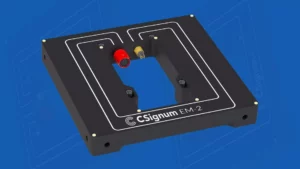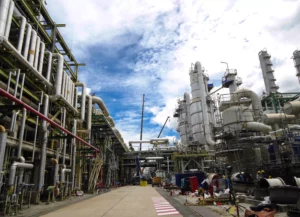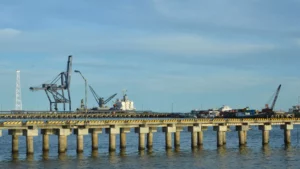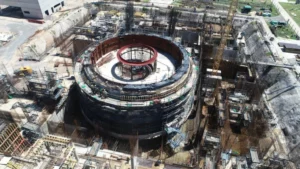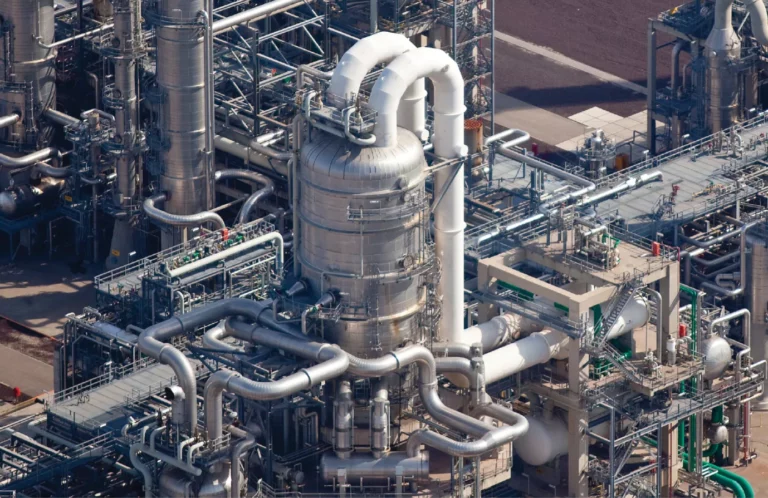Introduction
Steam reformer tubes used in the refining, petrochemical and fertilizer industries are manufactured by the centrifugal casting process of heat-resistant austenitic alloys, such as HK-40, HP-40 and HP-Niobium modified materials.
These tubes are prone to various degradation mechanisms such as creep, the useful life of these tubes depends largely on operation and maintenance. Additionally, as these tubes operate under severe conditions, determining the serviceability of these tubes beyond their design life of 100,000 operating hours is of vital importance.
In this context, Non-Destructive Testing (NDT) plays a fundamental role in detecting these failures. In this article, we will explore the power of simultaneously combining different NDT techniques in the inspection of steam reformer tubes, focusing on combined eddy current testing to evaluate permeability, ultrasound to evaluate attenuation and thickness measurement, and the evaluation diametral.
A set of tests that are applied simultaneously and in an automated manner is known as the H-Scan system, and the laser optical tube inspection system (LOTIS) that, combined with an array of specially designed eddy current probes, is known as the Leo system. Scan (Trademark Foerster).
Two approaches must be taken into account for the inspection of steam reformer tubes through combined Non-Destructive Testing, the first referring to the detection of brewing or brewing failures, and the second referring to the monitoring of the behavior of the material throughout the process. of the service, this second approach requiring highly repeatable techniques in order to compare the results over time and which will serve as a basis for estimating the useful life of the tubes.
Damage mechanisms in steam reformer tubes
A steam reformer consists of a reforming catalyst bed in thermal communication with a combustion source so that heat from the combustion chamber is transferred from the combustion reactions to the reformer catalyst to maintain the endothermic steam reforming reaction. . These systems can be large industrial scale or compact units designed for direct integration with a downstream hydrogen application.
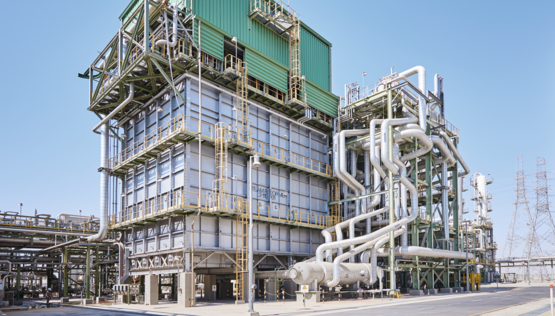
The main damage mechanisms in service that prevail in centrifugally molded tubes for reformer furnaces are the following:
- Creep: At elevated temperatures and stresses much lower than the high-temperature elastic limit, metals undergo permanent plastic deformation called creep. This is the main deterioration mechanism of reformer tubes and is a result of the combination of thermal stresses in the tube wall and internal pressure stresses. The creep damage process causes diameter increase and creep damage (cavitation) to the inner diameter.
- Thermal Shock: Thermal shock cracking can occur when high, non-uniform thermal stresses develop in a single event over a short period of time in a piece of equipment due to differential expansion or contraction. If thermal expansion/contraction is slowed, stresses greater than the elastic limit of the material may occur.
- High Temperature Oxidation: Steam reformer tubes operate at elevated temperatures and exposure to oxygen at high temperatures can cause oxidation of the tube material. This can lead to the formation of oxides, such as scale, which can reduce the mechanical strength and thermal conductivity of the tube.
- Sigma Phase Embrittlement: The formation of a metallurgical phase known as the sigma phase in some stainless steels when heated above 1000°F (540°C) can cause a loss of ductility and fracture toughness. Embrittlement can cause failure by cracking.
- Hydrogen attack (hydrogen embrittlement): Exposure to hydrogen at high temperatures can cause hydrogen to enter the steel matrix, causing embrittlement. This makes the material more susceptible to cracking, especially under stress. Hydrogen attack is a major problem in hydrogen production processes.
Combined Non-Destructive Testing techniques and systems for the detection and monitoring of degradation of steam reformer tubes
Induced Currents (ETC): Permeability Evaluation
Eddy currents are a widely used NDT technique to evaluate the permeability and thus the degradation of steam reformer tubes. These currents generate magnetic fields that interact with the material, allowing possible discontinuities to be detected. Measurement of magnetic permeability provides information on structural integrity and the presence of surface cracks.
It should be noted that this technique does not require a coupling medium such as water, which makes the results of the application highly repeatable and appropriate for monitoring the integrity of the tubes, however, when applied simultaneously with the ultrasound technique automated, which generally makes use of this means of coupling (H-Scan), loses its effectiveness in the repeatability of results and therefore in its use for monitoring the structural behavior of the tube material.
Automated Ultrasound (AUT): Evaluation of attenuation and thickness measurement
Creep damage in materials progresses with void nucleation, void growth, void delineation, and bonding to form microcracks and subsequently macrocracks. The parameters of the ultrasonic signal essentially depend on the properties and state of the medium through which they pass. By sending ultrasonic waves through the material, variations in backscattering attenuation reveal the presence of microcracks and damage at the interface between the grains of the material.
The main disadvantage of this technique is the influence of the tube surface condition, which can vary from soft, dimpled and tightly adhered scales, to loose scales, or a combination of all of these, which affect the ultrasonic signal and give the impression of creep damage.
Perfilometry (Measurement of diametral increase): Creep detection
It is used to detect growth in the tube diameter of reformer tubes through the use of mechanisms adapted to the scanner of Automated Ultrasound (AUT) and Induced Currents (ETC) instrumentation.
Laser Optical Tube Inspection System (LOTIS): Monitoring of diameter variations associated with Creep
The creep phenomenon, or slow deformation under constant load, is a challenge in reformer tubes due to the high temperatures to which they are exposed. The laser has become a valuable tool for monitoring diameter variations associated with creep.
By shining a laser beam onto the surface of the tube and measuring the reflection, it is possible to detect minute changes in the dimensions of the material. This technique allows evaluating the evolution of creep and anticipating possible structural problems, due to the high repeatability of the measurements obtained.
OD measurement is an important test to identify creep. The use of lasers for this inspection, apart from ensuring repeatability, allows the tube diameter to be digitally recorded along the entire length of the tube inside the reformer.
Radiography: Verification of defects
This test method is applied to check cracks/defects, detected with other inspection methods. Radiography is an ideal volumetric test for this type of inspection due to the difficulty of applying the ultrasound test due to the high sound attenuation in this type of materials and the irregular condition of the external surface of the material.
H-Scan System: Fault Detection
It is a combination of a set of NDT Non-Destructive Testing methods in which evaluations of ultrasonic attenuations, induced currents, dimensional measurements and integrated wall thickness data are carried out through a pneumatic scanner connected to imaging systems, and computer programs. which analyze the data and classify the scanned tubes into five grades based on their degree of damage.
Leo-Scan System: Detection and monitoring of material degradation
It is a combined Non-Destructive Testing system in which induced currents (up to a depth of 24 mm) and integrated Lotis are applied through a scaler-type scanner and from the outside of the tube (Leo-Scan), ideal when you want to detect trends in the furnace combustion profile and help identify areas with catalyst loading or catalyst condition problems. Problems with flue gas flow can also be determined using this data.
Another variant of the system is applied from inside the tube (Leo-iScan) and applicable when the tubes undergo catalyst replacement. Since the internal surfaces of the reformer tubes are machined, these readings readily show creep growth even in the absence of previous data (baseline).

Software for estimating the useful life of reformer tubes
Various softwares have been created to estimate the useful life of the tubes and through joint efforts in the absence of codes and practices that formally address the complexity of the useful life behavior of reformer tubes and using crack size and deformation data. .
In the past, estimates of this important value were based on the principles and elements of post-construction standards such as API 571, API 579, R5 and/or BS7910. However, the application of these standards is less than ideal, as they do not directly reflect the complexity of the damage mechanisms that affect the service life of reformer tubes.
Conclusions
In a world where safety and efficiency are imperative, combined Non-Destructive Testing stands as essential pillars in the detection and monitoring of steam reformer tubes. The use of combined Non-Destructive Testing through the integration of various techniques not only strengthens the detection capacity, but also lays the foundation for a future where technology will play an even more crucial role in preserving structural integrity in the chemical industry. By embracing these innovations, we take a firm step towards a safer and more reliable tomorrow in the production of essential elements for our modern world.
It is important to define the focus of these inspections (detection or monitoring), to establish the most imperative combined non-destructive testing systems or tests. In the case of an approach from a monitoring point of view, the most accurate useful life of the steam reformer tubes can be determined through the use of special software.
A first inspection is carried out externally and before the first commissioning of the unit to establish a zero base (baseline). If the inspection is carried out from the internal part of the tube (Leo-iScan), this prior inspection will not be required.
Bibliographic references
- GAUTAM DAS, D. DUTTA, KAUSHIK BORAL, GOURAB SEAL . Advanced NDTs for Inspection of Catalyst Tubes of Reformer Furnace; Consulted on November 28, 2023. https://www.ndt.net/article/apcndt2013/papers/258.pdf
- BRIAN SHANNON, CARL JASKE. A Comprehensive Approach to Reformer Tube Inspection and Assessment; Consulted on November 28, 2023; https://www.ndt.net/article/mendt03/shannon/shannon.htm
- FOERSTER . REFORMER TUBES AND COMPONENTS; Consulted on November 29, 2023; https://www.foerstergroup.com/fileadmin/user_upload/downloads/Broschueren/BROC_Branche_Reformer_2022_english_150_dpi.pdf
- API RP 571: Damage Mechanisms Affecting Fixed Equipment in the Refining Industry ; Consulted on November 30, 2023.





